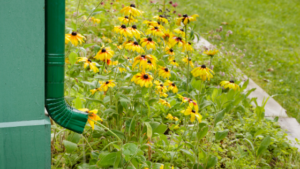When your yard drainage isn’t working, it can be very frustrating and lead to mosquitoes, mud, and dead grass. If you’re wondering how to fix a yard that holds water, we’ll go over several yard drainage solutions that can help provide you with better landscape drainage. But let’s start by taking a look at the causes of yard drainage issues.

Common Yard Drainage Causes
Several factors can cause issues with your yard drainage system, with different approaches to solve the problems based on what your issues may be.
- Yard slope: It’s much easier for water to pool up in a flat yard because the plane of the soil doesn’t move the water away from the home.
- Too-short downspouts: If the downspout from your gutter goes into a flower bed or other landscaping, excess water can collect there.
- Impacted soil: Happening from construction or soil conditions, impacted soils allow water to build up above these layers, making for boggy conditions.
- Walkways or sidewalks: Sidewalks and concrete paths can act like dams, preventing water from draining off of your yard and away from your home.
- Runoff erosion: Fast water movement causes soil to run off, which can then create a place for the moisture to collect in the newly-created hollow.
5 Yard Drainage Solutions
After figuring out your specific issue and its likely cause, here are a few options you can take on to improve your yard’s drainage.
1. Reduce Watering
Are you overwatering your yard or garden? Try to lower your watering amount and see if the trouble spots dry out. Though this is a simple solution, it’s not often the correct one, so if the problem persists, try other options.
2. Extend Downspouts
Is the runoff coming from your gutter system? Something as simply extending downspouts away from your home can help fix the problem, just make sure the water is diverted to a good drainage location. Make sure to take the time to clear your gutters every fall as well, to help prevent them from backing up.
3. Create a Creek Bed
Turn a soggy spot into a drainage swale or artificial creek. This can be as simple as adding gravel and rock to help prevent runoff from starting in areas where the water runs quickly and creating a beautiful piece of landscaping. You can also turn it into a rain garden, as we’ll discuss below, just make sure that these soggy spots don’t spread to the rest of your yard.
4. Build a Rain Garden
Low spots in your yard can collect water while lacking the slope to drain it. However, these can be a great place to create a rain garden, which is planted with ferns, hostas, ornamental mosses, and similar moisture-loving plants. Take the time to dig up a bit of the soil and amend it for good drainage, then arrange these thirsty plants to your liking.
5. Install a French Drain in Yard
When you can’t fix the yard drainage problems by making changes to the surface, going deeper with a French drain can make a big difference. These drains are installed underneath the surface to move excess water. You can combine it with a dry well for a very effective yard drainage system.
Check Your Yard Frequently for Continued Drainage Issues
These solutions may not be enough to keep your yard drainage dry, so it’s important that you regularly check your yard to ensure that these solutions continue to work, especially during wet conditions. If you’re continuing to see damp areas, problems with soil aeration or erosion, it may be time to call in the professionals to ensure that you’re getting a solid mix of yard drainage solutions that will deliver solid performance.
If you’re frustrated trying to figure out how to fix a yard that holds water, you’re not alone. At Moisture Loc, we have helped numerous customers find the right yard drainage system for their home’s needs. If you’re ready to fix the problems with your yard’s drainage, we’re happy to help. Please contact us today with any questions, for more details or to schedule a consultation with one of our experienced yard drainage professionals.
